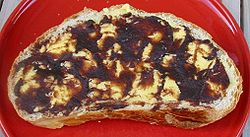Apple butter
 Apple butter on a slice of bread | |
| Type | Spread |
|---|---|
| Place of origin | Belgium and the Netherlands |
| Main ingredients | Apples, cider or water |


Apple butter is a highly concentrated form of apple sauce, produced by long, slow cooking of apples with cider or water to a point where the sugar in the apples caramelizes, turning the apple butter a deep brown. The concentration of sugar gives apple butter a much longer shelf life as a preserve than apple sauce.
Background
The roots of apple butter lie in Limburg (Belgium and the Netherlands), conceived during the Middle Ages, when the first monasteries (with large fruit yards) appeared. The production of the butter was a perfect way to conserve part of the fruit production of the monasteries [1] in that region, at a time when almost every village had its own apple butter producers.
The production of apple butter was also a popular way of using apples in colonial America, and well into the 19th century. There is no dairy butter in the product; the term 'butter' refers only to the thick, soft consistency, and apple butter's use as a spread for breads. Typically seasoned with cinnamon, cloves and other spices, apple butter is usually spread on bread, used as a side dish, an ingredient in baked goods, or as a condiment. Apple butter is also mixed with vinegar while cooking to provide a small amount of tartness to the usually sweet apple butter. The Pennsylvania Dutch often include apple butter as part of their traditional seven sweets and seven sours dinner table array.[2]
In areas of the American South, the production of apple butter is a family event, due to the large amount of labor necessary to produce apple butter in large quantities. Apple butter is also used on a sandwich to add an interesting flavor, but is not as commonly used as in historical times. Traditionally apple butter was and is prepared in large copper kettles outside. Large paddles are used to stir the apples and family members would take turns stirring.
In Appalachia, apple butter was the only type of fruit preserve normally rendered into fruit leather.
In Jersey, in the Channel Islands, apple butter is known as "black butter" or "lé nièr beurre" and has liquorice among its spices.
In Europe, apple butter is commonly used in the Netherlands where it is known as Appelstroop (Apple syrup) and frequently eaten on bread with (or without) thinly sliced cheese. A sweeter version, made using pears as well as apples, is more popular in Belgium where it is known as Liège syrup (Sirop de Liège/Luikse Siroop). Other than in Benelux, apple syrup is a minority taste in western Europe, although it is sold in Germany, generally in health food shops, as Apfelkraut, and a similar food is produced in francophone Switzerland where it is known as vin cuit.
Apple butter can be used as a fat substitute in reduced fat or fat-free cooking, as well as vegan recipes.[3][4][5]
Events
In various locations across the United States, the production of apple butter is associated with a community event, most often occurring in the fall at the end of the apple harvest season. At many of these events, apple butter is cooked on-site in the traditional method, using huge copper kettles over open fires that are stirred for hours.
Apple Butter Makin' Days has been held on the courthouse square in Mount Vernon, Missouri each October since 1967.[6] Kimmswick, Missouri,ref.http://www.gokimmswick.com/applebutter_festival.html,/ref> and Berkeley Springs, West Virginia[7] each have an annual apple butter festival as well.
Wellesley, Ontario has an annual Apple Butter and Cheese Festival [8] on the last Saturday in September.
Fenner Nature Center [9] in Lansing, MI also has an annual Apple Butter Festival on the third weekend of October.
Oak Glen, California has an Apple Butter Festival in November on Thanksgiving Weekend as part of the close of their official Apple Harvest Season.[10]
Origins
Since ancient times, prolonged cooking of fruit to reduce its volume has been used as a practical method of preserving fruit,[11] although the development of inexpensive canning and refrigeration technologies in the nineteenth and twentieth century reduced the importance of the traditional approaches. The term used in ancient Greek was siraion. During the centuries of Roman hegemony, writers such as Pliny the Elder,[12] the writer of Apicius[13] and Columella[14] also described the manufacturing process of the product to which they give various names depending on the degree of reduction from that of the original fresh ingredients, which typically was reduced to between a half and a third.
References
- ^ http://www.slowfood.nl/userfiles/publicaties/177_sf_arkvdsmaakbrochure_lowres.pdf (in Dutch)
- ^ Ken Albala, "Food and faith in Christian culture". Columbia University Press, 2011. p.157 [1]
- ^ http://www.foodsubs.com/Fatsoils.html
- ^ http://www.uihealthcare.com/topics/medicaldepartments/cancercenter/colorfulplate/desserts/bakingsubs.html
- ^ http://wiki.answers.com/Q/What_are_vegan_substitutes_for_butter
- ^ http://www.mtvernonchamber.com/mt_vernon_applebuttermakindays.php
- ^ http://www.berkeleysprings.com/apple/
- ^ Apple Butter and Cheese Festival
- ^ Fenner Nature Center
- ^ http://snow-line.com
- ^ The Food museum at Vevey contains a jar of vin cuit dating from 1939 that is still usable.
- ^ Pliny the Elder, Natural History 14:180
- ^ Apicius, De re coquinaria ("On Cookery"), e.g. recipes 192 and 335.
- ^ Columelle, De Re Rustica ("Country Matters"), chapter 12,21,1
External links
- "Stirring Up The Past", WBGU-PBS documentary Grand Rapids (Ohio) Applebutter Festival
- Apple butter recipe
- The original easy apple butter recipe
